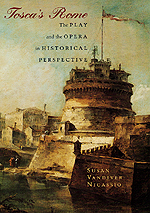With the 2010 season under way, we at Glimmerglass feel it’s time to delve into some opera-related summer reading! Over the next few weeks, we will be recommending books related to each of the operas and their composers.

The first pick is Tosca’s Rome: The Play and the Opera in Historical Perspective (University of Chicago Press, 1999), by Susan Vandiver Nicassio. Available at Amazon.com.
In this study of the historical origins of Tosca, Nicassio reveals the setting of Puccini’s opera as a convenient window onto the history of Rome in the early 19th century. While the rest of Europe was still riding the euphoria of the French Revolution, Rome under the newly reinstated Papal State proved a precarious venue for liberal thought, especially in the world of the arts. It is in this world where Nicassio finds the soprano Floria Tosca, her well-to-do but recklessly patriotic lover, the painter Mario Cavaradossi, and his friend, the political fugitive Angelotti. Imposing on all three is the strong arm of the Roman beaurocracy, embodied in the lecherous and flagrantly corrupt Baron Scarpia.
Nicassio divides her historical overview into three chapters–“the Painter’s Rome,” “the Singer’s Rome,” and “the Policeman’s Rome”–in each section undertaking a thorough case study of the social contexts in which the opera’s characters begin to emerge as fully-developed, complex actors on a shared stage. For Floria Tosca, theater under the religious state would have been an oppressive environment, especially for a rising female soprano–this was, after all, still the age of the castrati, and female singers had only recently been allowed to perform in public. Nicassio gives a thorough account of the trials and tribulations surrounding the arts, from performance practice to regulations on the opera houses themselves. Likewise, she reveals Cavaradossi’s Rome as just as highly policed, an inhospitable environment in which free-thinking artists worked under the constant scrutiny of the state. Like the impresarios and performers of the stage, the painter’s only avenue of dissent was through his art.
Of particular interest is Nicassio’s history of Roman law under the religious state. She sheds light on the complicated web of beaurocracy that was Rome following several political upheavals and struggles for power during a wave of revolutions. Straddling the blurred line between religious and political jurisdiction, Scarpia becomes a kind of caricature of the worst of both worlds, and yet somehow emerges as more human than we are generally encouraged to see him.
The second half of Tosca’s Rome deals with the opera itself, as Nicassio presents a comprehensive walk-through of the dramatic action. She gives a thorough synopsis of the opera’s plot, pausing at each event to provide insight into the historical contexts informing the character’s actions. Not only does she allow us to see who they are in context, but we are afforded a glimpse into why they behave the way that they do. The end result is a renewed sense of gravity as we witness the decisions that lead to the tragic deaths of the opera’s protagonists. Her analyses of critical scenes are astute without being overly technical, and she draws frequently upon examples from the music as it appears in the score. For those interested in the opera’s theatrical origins, Nicassio continually references Victorien Sardou’s 1887 play, on which Puccini’s Tosca is based.
One of the most interesting aspects of Tosca’s Rome is the parallel Nicassio draws between this liminal period in history and the modern day, as we transition into the 21st century. Glimmerglass’ production of Tosca is set in a nonspecific time period, informed by the universal themes of Puccini’s opera. In fact, the more Nicassio delves into historical analysis, the more these themes and the timelessness of Tosca connect us to the world in which it was created.
